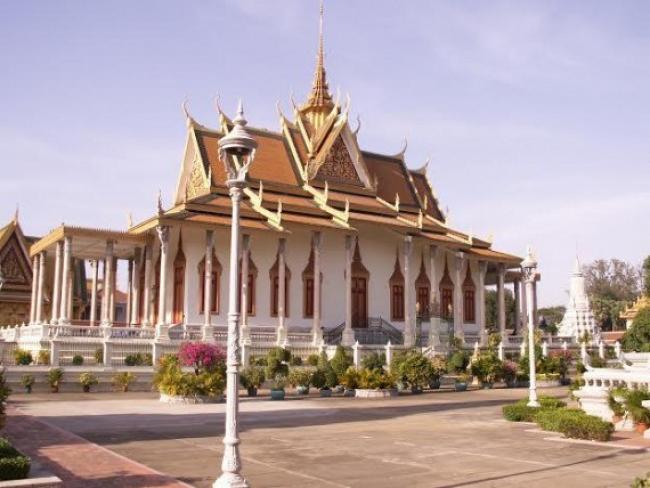Travelogue
Travelogue
Death and courage
01 Jan 2017, 07:46 pm

The death of famous journalist Sydney H. Schanberg whose accounts of Cambodia on throes of civil war was the core of the prize-winning "The Killing Fields" makes Ranjita Biswas recall her visit to the infamous site
.jpg)
Sydney H. Schanberg, the Pulitzer Prize winning journalist has died at age 82. For generations of readers and newspaper hacks, his name stood for integrity, compassion and daring in the face of adversity. Forty years ago, his reports in the New York Times on the situation in Cambodia with a fast advancing Khmer Rouge army brought the world closer to what was happening in this corner of South East Asia. Even more remarkable was the way he stood by his assistant from Cambodia, Dith Pran, and saw to it that his family was flown out safely to the USA. Dith Pran was thrown into a hard labour camp, survived, escaped through the Thailand border, and could join his family after a couple of years.
Schanberg’s personal story of the days in Cambodia before it plunged into anarchy was later turned into the Oscar-winning film The Killing Fields.
.jpg)
Thinking of the demise of Schanberg brought me memories of visiting the location of the ‘killing fields’ at Choeung Ek, not far from Phnom Penh, Cambodia’s capital. Here the country keeps alive the memories of those horrific times, much like the Holocaust sites in Europe, as if to etch in human consciousness what can happen if a twisted ideology and a sadistic ruler combine to destroy one’s own country. Pol Pot, the Khmer Rouge supremo had let loose a reign of terror seldom seen in post World War time anywhere in the globe.
Thousands died of starvation due to an experiment to turn the country into a Utopian agrarian economy at one stroke, execution for perceived opposition to the regime or even for being ‘educated’. Dith, in fact, survived the camp by pretending to be illiterate.
More than a million country men are estimated to have been killed during the Pol Pot regime between 1975-79 till the Vietnamese guerrillas took over.
.jpg)
A memorial glass stupa built in 1988 at Choeung Ek displays some 8000 skulls of those who were condemned to death, earning it the sobriquet ‘Bone Museum’. In 1980, the remains of the dead, many of whom were bound and blindfolded, were exhumed from mass graves in the killing field what was once an orchard; 43 of the 129 communal graves have been left untouched but you can see the grave sites.
Standing in front of the glass stupa, even the most blasé would perhaps be unable to stop tears welling up. The enormity of the crime silences the tongue and the notice to ‘be silent’ does not need reminding; it comes automatically. At the entrance, attendants ask you to take off the shoes, enquire gently if you would like to take the joss sticks and flowers – provided free- to offer prayer in memory of the dead. At least those departed receive respect to their lives that they missed during lifetime.
Every year, on 9 May a memorial ceremony is held at Choeung Ek
Not far from here is the Genocide Museum at Tuol Sleng which was an infamous torture chamber of Pol Pot’s security forces. Originally it was the Tuol Svay Prey High School which was turned into a prison known as Security Prison 21 (S-21). Between 1975 and 1978 more than 17,000 people were held at S-21 and then taken to Choeung Ek, for execution or burial . Like the Nazis the perpetrators kept meticulous account of the prisoners and the cruel interrogation methods which are now displayed in B&W pictures at the museum. Indeed, it needs mental fortification to encounter these pictures. Only seven had survived this prison out of the thousands.
Yet, while going around Cambodia with its gentle-mannered people and swaying green fields, it’s hard to believe that it had spouted a monstrosity like Pol Pot and his army of deviants.
.jpg)
In Phnom Penh, the Royal Palace with its white buildings with maroon and yellow panels, the Silver Pagoda and famed Emerald Buddha, temples with fluted roofs, graceful women dancers enacting the story of the Ramayana, denote a country of high culture. Not to forget, the vast complex at Angkor Wat of Khmer Rouge empire that never stops to astound.
The memorial at the killing fields , the limbless men, women and children paying the price of stepping on mines left behind by the defeated Khmer Rouge but now picking up the threads, playing music or learning to cope, remind of history’s unsavoury footsteps and human resilience to cope.
Images: By author and screenshots of Beyond Killing Fields Official Website
More Travelogue
- From Kennedy’s Proposal to 1850s Saloons: The Three Historic D.C. Restaurants Everyone Must Try
- This city has the best bagel in the US, and it’s not New York!
- I escaped to Pachmarhi — what I found in the queen of Satpura left me spellbound
- Air Canada just ranked the Best New Restaurants of 2025 - And the Top Spot isn't who you think
- Rediscovering Arunachal's Monpa Cuisine: One Woman’s Millet Momo Revolution
- Discovering Heritage: A visual journey through Odisha crafts museum Kalabhoomi
- From kebabs to biriyani: Lucknow gets UNESCO honour for its royal cuisine
- Delta takes Spanish flavours to the skies
- Kolkata’s iconic Kathi Roll among world’s top 10 wraps: TasteAtlas
- Yellow Taxis and the Colours of Puja
Toronto to Rio: Air Canada ...
Air Canada has introduced a new non-stop route connecting Toronto with Rio de Janeiro, with the first flight landing in the Brazilian city on Friday morning.
Air India's partnership wit ...
Air India, India’s leading global airline, and Maldivian, the national airline of the Maldives, have entered a bilateral interline partnership aimed at boosting connectivity between the two countries.
Massive meltdown at IndiGo: ...
IndiGo, India’s largest airline, is grappling with one of its most severe operational crises in recent years, with widespread flight delays and cancellations disrupting travel across the country for a second consecutive day.





